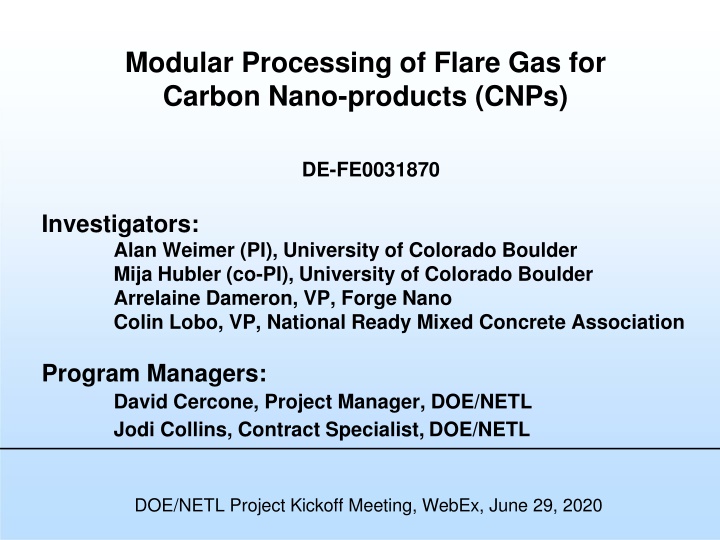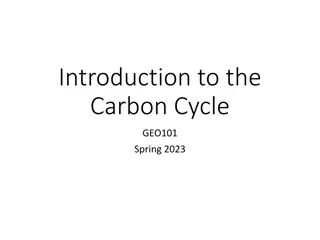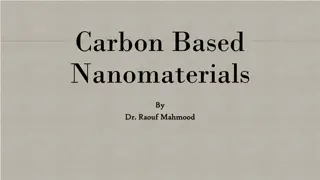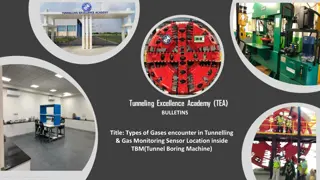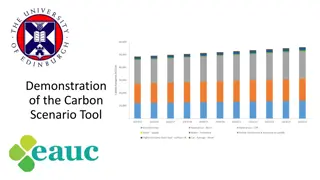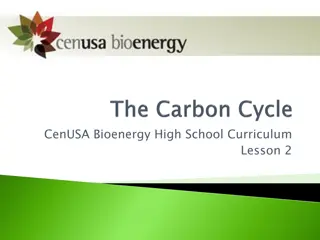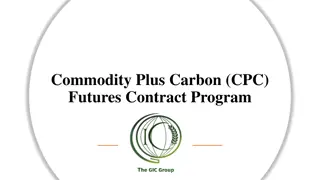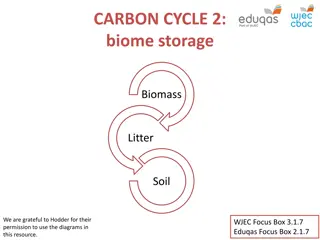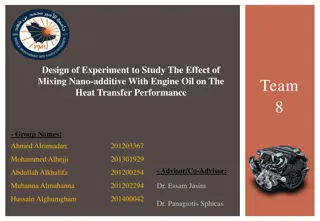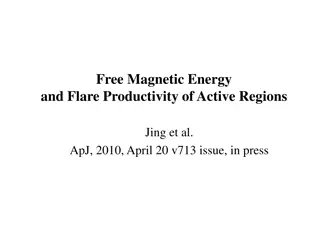Sustainable Conversion of Flare Gas into High-Value Carbon Nano-products
This project focuses on modular processing of flare gas to produce carbon nano-products, aiming to address the challenges of natural gas flaring in the United States. With a three-year timeline and a total budget of $3,750,000, the interdisciplinary team led by the University of Colorado Boulder seeks to convert flare gas into valuable carbon products, reducing greenhouse gas emissions and generating revenue. By leveraging innovative technologies, this initiative represents a profitable and sustainable alternative to traditional gas flaring practices.
Download Presentation

Please find below an Image/Link to download the presentation.
The content on the website is provided AS IS for your information and personal use only. It may not be sold, licensed, or shared on other websites without obtaining consent from the author.If you encounter any issues during the download, it is possible that the publisher has removed the file from their server.
You are allowed to download the files provided on this website for personal or commercial use, subject to the condition that they are used lawfully. All files are the property of their respective owners.
The content on the website is provided AS IS for your information and personal use only. It may not be sold, licensed, or shared on other websites without obtaining consent from the author.
E N D
Presentation Transcript
Modular Processing of Flare Gas for Carbon Nano-products (CNPs) DE-FE0031870 Investigators: Alan Weimer (PI), University of Colorado Boulder Mija Hubler (co-PI), University of Colorado Boulder Arrelaine Dameron, VP, Forge Nano Colin Lobo, VP, National Ready Mixed Concrete Association Program Managers: David Cercone, Project Manager, DOE/NETL Jodi Collins, Contract Specialist, DOE/NETL DOE/NETL Project Kickoff Meeting, WebEx, June 29, 2020
Project Elements/Overview Awarded under DOE DE-FOA-0002006 - AOI 2B - Modular Equipment and PI Design Concepts for Conversion of Flare Gas to High-Value Carbon Products Interdisciplinary team between one university (two departments), an industry partner, and an expert product association University of Colorado Boulder (Lead) Forge Nano (industry subcontractor) National Ready Mixed Concrete Association (non-profit association subcontractor) Three-year project started on May 1, 2020 Total project budget: $3,750,000 ($3,000,000 from DOE and $750,000 from the participants as costshare)
Background Natural Gas Flaring Natural gas production in the United States has risen dramatically due to the shale boom and wide implementation of hydraulic fracturing; With gas prices at historic lows, it is generally not cost effective to invest in expensive infrastructure to transport gas, resulting in increased flare volumes; According to the EIA, approximately 36% of natural gas extracted in 2012 in North Dakota did not make it to market, with 29% of that gas being flared; although flaring dropped in subsequent years preceding 2015, the percentage of gas flared in October, 2018 in North Dakota grew to 20 percent, the highest the state has seen since August 2015; This translates to about $1 billion in lost revenue, and greenhouse gas emissions equivalent to adding 1 million cars to the road. Producers often exhaust tight oil wells rather quickly because production from a single well depletes rapidly.
Daily Production Rate from a Typical Tight Well ~ 20X decrease in 1st 5 years 700 Mcf/d 30 Mcf/d Mcf/day
Proposed Profitable Alternative Distributed NG de-carbonization to value-added product Chemical vapor deposition (CVD) to carbon nano-product (CNP) CNP (carbon powder and carbon nanofibers) is value-added concrete additive for infrastructure Sequesters carbon in concrete & decreases CO2 emissions CNP addition to concrete could double concrete lifetime Reduce CO2 emissions by 0.9 to 1.4 B kg CO2/yr Build mobile CVD reactors that can be deployed as needed Simple 1-step chemical process (CH4 CNP + 2H2) Use sacrificial catalyst, eliminating expensive separation to recycle the catalyst; burn resulting H2 with unreacted CH4 to supply heat needed to drive the reaction Similar to commercial gas phase polymerization
Proposed Process Schematic CHEN CVEN
Proposed Process Schematic CHEN CVEN
Proposed Process Schematic NewCo NRMCA Forge Nano
Proposed Process Schematic NewCo CHEN NRMCA Forge Nano CVEN
CVD Using a Sacrificial Catalyst CH4 C + 2H2
CVD Using a Sacrificial Catalyst CH4 C + 2H2
Complete R&D Effort of the Project Overall Objective: Develop a simple and low-cost, CVD, one-step, modular/mobile process to grow CNPs on a sacrificial catalyst that will improve the durability of concrete (achieve TRL 5)
The Team Alan Weimer (PI) Professor, Chemical Engineering, University of Colorado Boulder (CU) Particle ALD, fluidization, solids processing, high-temperature chemistry Kent Warren, Post Doctoral Associate Gage Sowell, Jessica Hauck (pending), GRAs Theodore Champ, Research Assistant Mija Hubler (Co-PI) Asst. Professor, CVEN, CU Cementitious materials, microstructure design, fracture mechanics Linfei Li, Post Doctoral Associate (FN pending) Arrelaine, Dameron R&D Director, Forge Nano (FN) Andy Broerman, Principle Engineer Colin Lobo VP Engineering, National Ready Mixed Concrete Assocation (NRMCA)
Roles, Responsibilities and Collaborations (Project Management) Task 1: Project Management & Planning Task 2: Particle ALD Catalysis and CVD Synthesis Range Finding Task 3: Design and construction of modular process Task 4: Cement Mix Design using Commercially Available CNPs Task 5: Bulk Production of CNPs and Technology to Market Task 6: Cement Mix Design using Produced CNPs Weekly 1 hr Meetings (Mondays 1300-1400, MST)
Pressurized CVD Lab Reactor System Capable of operating up to 450 psig and 900oC CNFs grow on the fluidized catalyst/silica fume particles Inconel or high-temp SS reactor tube/components Reaction progress measured by in-situ mass spectrometer/NDIR at outlet
Experimental Plan Design methods leveraged to reduce experiment plan complexity, while maximizing insight Catalyst synthesis: metal, cycle number, reaction temperature CVD/CNF Growth: Gas hourly space velocity of natural gas, operating pressure Mole Fraction (%) Species CH4 C2H6 C3H8 C4H10 H2S CO2 N2 He Total 52.7 24.6 12.9 1.3 3.8 2.8 0.0 0.4 98.5
Particle ALD Catalyst Adatom nanoparticles (Fe, Co, or Ni) uniformly deposited on silica fume via ALD Maintain catalytic activity Remain stable, e.g., resist further oxidation upon exposure to air Promote efficient use of the metal/M-ocene precursors Clary, Jacob M., et al. "Highly dispersed Co deposited on Al2O3 particles via CoCp2 + H2 ALD." Nanotechnology 31.17 (2020): 175703.
Envisioned Process Flow Diagram for R&D Skid separation Gas Solid Product gas to safe location Gas Analysis Fresh Catalyst Electric furnace Fluidized reactor Feed Gas Mixing CNT Product
Envisioned Industrial Mobile Skid Gas out ALD Catalyst Storage Optional Regenerative Burner ALD Catalyst Lock Hopper Heat Reactor 700- 900 C Air Exhaust ALD Catalyst Heat Product Natural Gas Feed Agglomerator And Storage Lock Hopper and Cooling
Ready Mixed Concrete Concrete - most used construction material US Consumption (2019) Cement 100 M metric tons Concrete 500 M cu. yds. (RMC = 370 M yd3) Industry Value (USGS) Cement - $12.5B Concrete - $65B Average Price Cement - $120 150 / t Concrete - $100 500 / yd3 Vol. 6% 10% Wt. 0% 15% Air Cement 18% 10% Water Sand 25% 30% Stone 40% 45%
Ready Mixed Concrete Concrete is versatile Design for varying strength, durability, aesthetics Strong, resilient, minimum maintenance Long service life 20, 50, 100+ years Cement manufacture attributed to 5% global CO2 Calcination of limestone Burning fossil fuels Concrete uses recycled materials to minimize cement use Ash from burning coal Slag from iron manufacture Other materials Contributes to sustainable construction Design and structural efficiency Resilience, energy use, service life, End of life recycling
Scientific Principles & Objectives for CNF Integration into Concrete - Identify optimal processing methods - Determine permeability mechanisms - Standard product testing - Determine cracking mechanisms - Establish governing-processing-performance relations
TEA - Flare Gas Properties Planned Site Location: Bakken Region, North Dakota Average Flare Volume, 2018: 27.4 MCF per day1 Composition of Flare Gas Stream1 Inlet pressure: 500 psi (34.47 bar) Species Mole Fraction (%) 52.7 24.6 12.9 1.3 3.8 2.8 0.0 0.4 98.5 2 CH4 C2H6 C3H8 C4H10 H2S CO2 N2 He Total 1 National Energy Technology Laboratory, personal correspondence 2 Wikimedia Commons, https://commons.wikimedia.org/w/index.php?curid=5667339
TEA - Process Flow Diagram Flare Gas Feed 1,142 scf hr -1 Catalyst & Support 16.8 kg hr -1 CNF 900 C 34.2 bar 70% conv 560 C Mole Fractions 73% N2 9.1% O2 2.9% CO2 15% H2O 99.9% H2 23,800 scf hr -1 Air
TEA - Process Simulation Heat Streams (Negative is exothermic) C1: -6950 cal/sec C3: -5509 cal/sec BURNER: -19922 cal/sec C2: -1748 cal/sec C4: -42483 cal/sec CVDRXR: 75022.6 cal/sec
Scope of Work Three Budget Periods Budget Period I (17 months): Build lab research reactor process & initiate Particle ALD catalyst/CVD process research, preliminary TEA, pilot skid designed & construction started, concrete studies with purchased CNPs Budget Period II (12 months): Build pilot skid & start up, Test particle ALD mixed-metal catalysts & select preferred catalyst and operating conditions (T, GHSV, ), optimize cement mix design using purchased CNPs, TEA will be updated Budget Period III (12 months): Optimize pilot skid performance and produce CNPs for in-house testing, optimize cement mix design using in-house produced CNPs, kinetics studies using preferred catalyst, finalize TEA and T2M
Gantt Chart Budget Period 1 Budget Period 2 Budget Period 3 FYQ2 Q1 FYQ3 Q2 FYQ4 Q3 FYQ1 Q4 FYQ2 Q5 FYQ3 Q6 FYQ4 Q7 FYQ1 Q8 FYQ2 Q9 FYQ3 Q10 FYQ4 Q11 FYQ1 Q12 FYQ2 Q13 FYQ3 Q14 Task Name Team Task 1.0 - PM&P Subtask 1.1 Subtask 1.2 Subtask 1.3 Task 2.0 ALD & CVD Subtask 2.1 Milestone A Subtask 2.2 Milestone B Task 3.0 Module Design Subtask 3.1 Milestone C Subtask 3.2 Milestone D Task 4.0 Cement Subtask 4.1 Milestone E Subtask 4.2 Milestone F Task 5.0 Commercialization All Subtask 5.1 Milestone G Subtask 5.2 Subtask 5.3 Task 6.0 Cement + Carbon Hubler Subtask 6.1 Subtask 6.2 Weimer PMP - 30 days after award, revisions as requested TMP - 60 days after award, updates as needed TEA - 180 days after award, revisions as requested Weimer Forge Nano Hubler
Deliverables (Tasks 2 to 6) Planned Completion Date End of Q6 Task/ Subtask Milestone Title & Description Verification method A: The Lab Particle ALD FBR reactor system is started up Go/No Go Minimum fluidization velocity determined for fumed silica at up to 900oC. The solid product will comprise at least 25 wt% as measured using LECO combustion analysis Review by engineer leading construction Production of carbon nanoproduct from associated gas at the prescribed scale Minimal (< 3 min) reduction in set time and an improved ductility compared to the baseline mix. 2.1 End of Q8 B: CVD will be carried out 2.2 C: Complete plans for module construction End of Q6 3.1 End of Q10 D: Pilot skid is started up Go/No Go 3.2 End of Q4 E: Mix design including carbon products 4.1
Deliverables (Tasks 2 to 6) Planned Completion Date End of Q6 Task/ Subtask Milestone Title & Description Verification method Meet UHPC performance metrics using commercially available carbon nanoparticles and CNFs. F: Optimal cement mix design parameters will be identified 4.2 End of Q13 Minimal (< 3 min) reduction in set time and an improved ductility compared to the baseline mix. G: Mix design including produced carbon product from sacrificial adatom catalyst 5.1 End of Q14 H: Cement mix design parameters will be identified for mixes that meet UHPC performance using carbon products synthesized from sacrificial adatom catalyst. End of Project (final report) Meet compressive strength, flowability, flexural strength, and hydration time of UHPC using synthesized carbon products. 6.2
Success Criteria Phase 1: Solid CNPs are synthesized using ALD processes in the lab; Phase 2: A pilot modular unit designed by CU and Forge Nano, constructed at CU, and set up at Forge Nano for experimentation; Phase 3: Cement cylinders containing the CNPs which meet or exceed UHPC performance metrics; Phase 4: The pilot unit demonstrates methane decarbonization producing the CNPs in bulk (>1kg of carbon product) and meeting metrics prescribed in Task 5. Final Project Success: A TRL=5 is achieved
Risk Management Risk Rating Impact Overall (Low, Med, High) Mitigation/Response Strategy Probability Perceived Risk Technical/Scope Risks: Performance of the catalyst Med Med Med Consider multiple catalysts simultaneously to discover the best performing one Management, Planning, and Oversight Risks: Hiring challenges for GRA or PRA Low High Med Initiate search immediately upon award and transition those already at CU ES&H Risks: Nanoparticle release Low High Med Agglomerate and disperse all carbon products in liquids
Budget Spend Plan by Fiscal Year Format FY 2020 FY 2021 FY 2022 FY 2023 Total DOE Funds Cost Share $0 DOE Funds $754,927 Cost Share $0 DOE Funds $479,825 Cost Share $0 DOE Funds $113,766 Cost Share $0 DOE Funds $2,225,048 Cost Share $0 CU, Boulder $876,530 $64,837 $202,340 $119,962 $237,907 $432,097 $246,521 $133,104 $63,232 $750,000 $750,000 Forge Nano $3,168 $0 $6,885 $0 $11,660 $0 $3,239 $0 $24,952 $0 NRMCA $944,535 $202,340 $881,774 $237,907 $923,582 $246,521 $250,109 $63,232 $3,000,000 $750,000 Total ($) Total Cost Share % 17.64% 21.25% 21.07% 20.18% 20%
